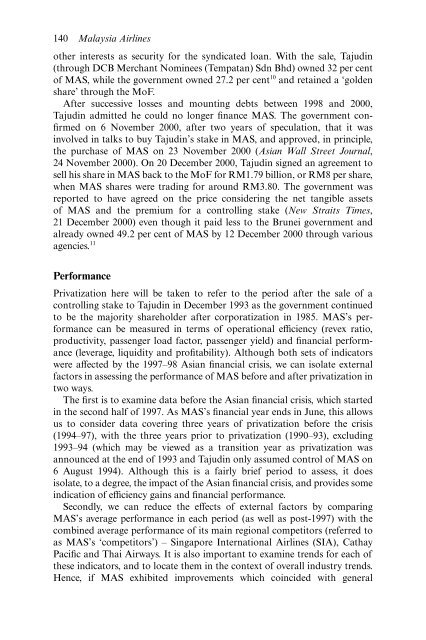PRIVATIZATION Privatization in Malaysia, Regulation, rent-seeking and policy failure
PRIVATIZATION Privatization in Malaysia, Regulation, rent-seeking and policy failure
PRIVATIZATION Privatization in Malaysia, Regulation, rent-seeking and policy failure
Create successful ePaper yourself
Turn your PDF publications into a flip-book with our unique Google optimized e-Paper software.
140 <strong>Malaysia</strong> Airl<strong>in</strong>esother <strong>in</strong>terests as security for the syndicated loan. With the sale, Tajud<strong>in</strong>(through DCB Merchant Nom<strong>in</strong>ees (Tempatan) Sdn Bhd) owned 32 per centof MAS, while the government owned 27.2 per cent 10 <strong>and</strong> reta<strong>in</strong>ed a ‘goldenshare’ through the MoF.After successive losses <strong>and</strong> mount<strong>in</strong>g debts between 1998 <strong>and</strong> 2000,Tajud<strong>in</strong> admitted he could no longer f<strong>in</strong>ance MAS. The government confirmedon 6 November 2000, after two years of speculation, that it was<strong>in</strong>volved <strong>in</strong> talks to buy Tajud<strong>in</strong>’s stake <strong>in</strong> MAS, <strong>and</strong> approved, <strong>in</strong> pr<strong>in</strong>ciple,the purchase of MAS on 23 November 2000 (Asian Wall Street Journal,24 November 2000). On 20 December 2000, Tajud<strong>in</strong> signed an agreement tosell his share <strong>in</strong> MAS back to the MoF for RM1.79 billion, or RM8 per share,when MAS shares were trad<strong>in</strong>g for around RM3.80. The government wasreported to have agreed on the price consider<strong>in</strong>g the net tangible assetsof MAS <strong>and</strong> the premium for a controll<strong>in</strong>g stake (New Straits Times,21 December 2000) even though it paid less to the Brunei government <strong>and</strong>already owned 49.2 per cent of MAS by 12 December 2000 through variousagencies. 11Performance<strong>Privatization</strong> here will be taken to refer to the period after the sale of acontroll<strong>in</strong>g stake to Tajud<strong>in</strong> <strong>in</strong> December 1993 as the government cont<strong>in</strong>uedto be the majority shareholder after corporatization <strong>in</strong> 1985. MAS’s performancecan be measured <strong>in</strong> terms of operational efficiency (revex ratio,productivity, passenger load factor, passenger yield) <strong>and</strong> f<strong>in</strong>ancial performance(leverage, liquidity <strong>and</strong> profitability). Although both sets of <strong>in</strong>dicatorswere affected by the 1997–98 Asian f<strong>in</strong>ancial crisis, we can isolate externalfactors <strong>in</strong> assess<strong>in</strong>g the performance of MAS before <strong>and</strong> after privatization <strong>in</strong>two ways.The first is to exam<strong>in</strong>e data before the Asian f<strong>in</strong>ancial crisis, which started<strong>in</strong> the second half of 1997. As MAS’s f<strong>in</strong>ancial year ends <strong>in</strong> June, this allowsus to consider data cover<strong>in</strong>g three years of privatization before the crisis(1994–97), with the three years prior to privatization (1990–93), exclud<strong>in</strong>g1993–94 (which may be viewed as a transition year as privatization wasannounced at the end of 1993 <strong>and</strong> Tajud<strong>in</strong> only assumed control of MAS on6 August 1994). Although this is a fairly brief period to assess, it doesisolate, to a degree, the impact of the Asian f<strong>in</strong>ancial crisis, <strong>and</strong> provides some<strong>in</strong>dication of efficiency ga<strong>in</strong>s <strong>and</strong> f<strong>in</strong>ancial performance.Secondly, we can reduce the effects of external factors by compar<strong>in</strong>gMAS’s average performance <strong>in</strong> each period (as well as post-1997) with thecomb<strong>in</strong>ed average performance of its ma<strong>in</strong> regional competitors (referred toas MAS’s ‘competitors’) – S<strong>in</strong>gapore International Airl<strong>in</strong>es (SIA), CathayPacific <strong>and</strong> Thai Airways. It is also important to exam<strong>in</strong>e trends for each ofthese <strong>in</strong>dicators, <strong>and</strong> to locate them <strong>in</strong> the context of overall <strong>in</strong>dustry trends.Hence, if MAS exhibited improvements which co<strong>in</strong>cided with general


